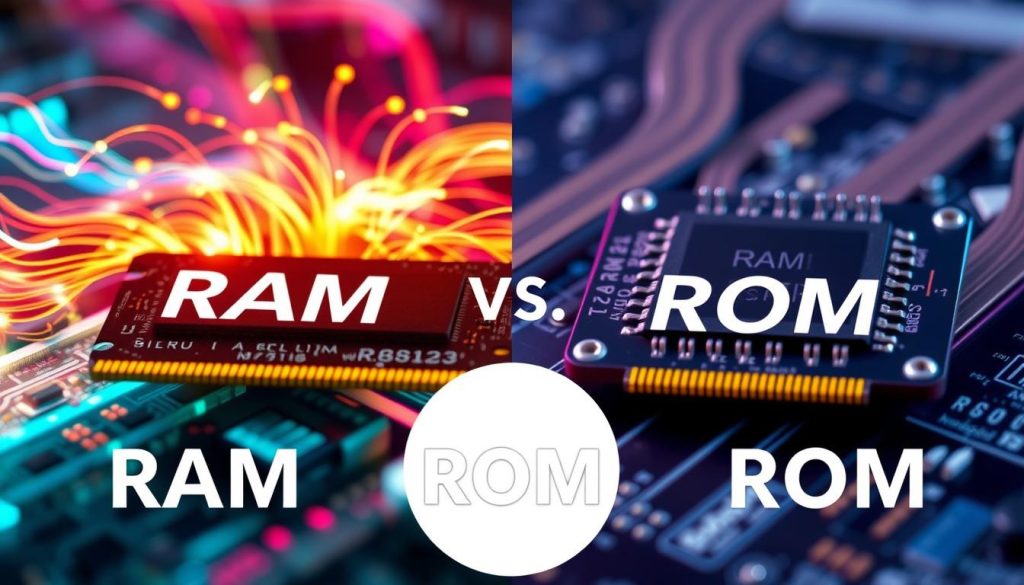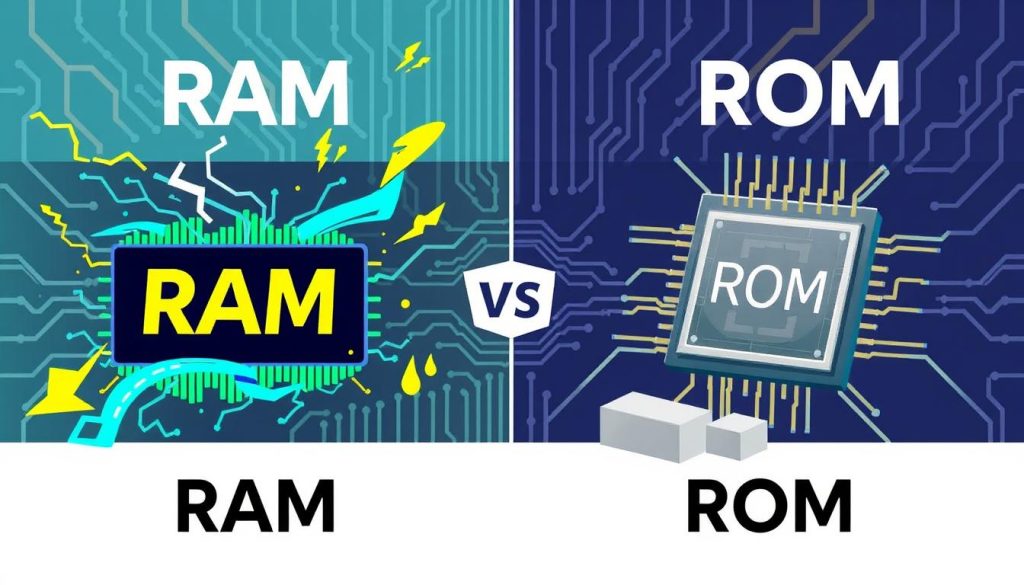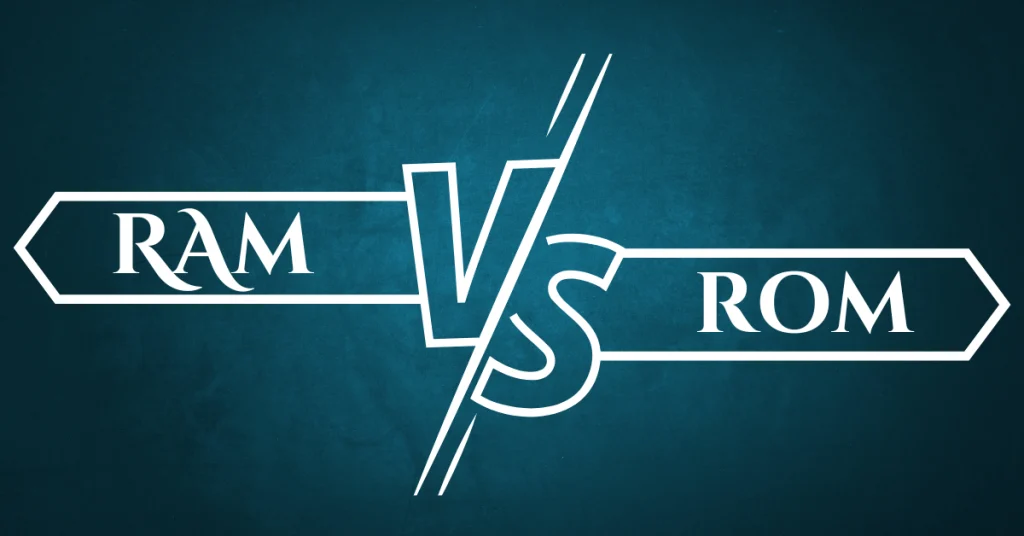Ever wondered why your device acts slow when running apps? It’s because of RAM and ROM. Knowing the difference is key to better performance. We’ll explore how RAM and ROM work and why they matter.
Let’s dive into the world of RAM and ROM. We’ll look at their roles in making your device fast and efficient. Join us to learn more about RAM and ROM and how they affect your tech choices.

Key Takeaways
- RAM (Random Access Memory) is volatile and essential for active processes.
- ROM (Read-Only Memory) is non-volatile and retains data even when powered off.
- The difference between RAM and ROM directly influences a device’s performance.
- RAM significantly affects speed, while ROM holds essential boot data.
- Understanding the RAM vs ROM relationship aids in making informed tech choices.
- Both memory types play crucial roles in optimizing user experiences.
Understanding RAM and ROM
RAM and ROM are key in computer memory. Knowing about them helps us see how devices handle data and apps. They each have their own job, affecting how well devices work.
What is RAM?
RAM stands for Random Access Memory. It’s a type of memory that’s lost when the power goes off. It’s used for quick data access, helping computers work well with many tasks at once.
Also Read: Myth vs Fact: Exploring the Difference
What is ROM?
ROM means Read-Only Memory. It keeps data safe even when the power is off. It’s used for things like starting up devices and storing important apps. ROM’s data doesn’t change much, unlike RAM which changes a lot.

Difference Between RAM and ROM
RAM and ROM are key to how computers work. Each has its own special traits. Knowing these helps us understand their roles in devices.
Key Characteristics of RAM
RAM is fast and changes easily. It’s great for running many programs at once. It’s like a temporary helper for your computer.
When you turn off your computer, RAM forgets everything. This is okay because it helps your computer work fast. It’s perfect for games and hard tasks.
Key Characteristics of ROM
ROM is different. It keeps data safe even when turned off. It’s like a permanent note for your computer.
ROM is key for starting up your computer. It holds important instructions. It’s not as changeable as RAM, but it’s reliable.

RAM vs ROM Speed
The speed of RAM and ROM is key to a device’s success. RAM is faster than ROM, perfect for quick data access. This speed difference affects how well a device works.
Performance Comparison
RAM’s speed helps with multitasking and app smoothness. A quicker RAM means a device can do more at once. This makes the user experience better.
Learn More: The Difference Between Android and iOS Smartphones
ROM’s speed is important for how fast a device starts up. If ROM is slow, starting up takes longer. This also slows down getting to important software.
How Speed Affects Device Performance
Looking at RAM vs ROM shows how speed matters. RAM’s speed makes a big difference in how fast a device responds. If RAM is slow, things can feel slow.
ROM’s speed, though, is more about how fast a device starts. A slow ROM means a longer wait to start up. It also slows down getting to software.
| Memory Type | Typical Speed | Impact on Performance |
|---|---|---|
| RAM | 10-20 GB/s | Supports smooth multitasking and quick application launching. |
| ROM | 100 MB/s – 1 GB/s | Affects boot times and firmware loading speeds. |
RAM vs ROM Storage
RAM and ROM have different storage capacities. They meet different computing needs. Knowing these differences helps improve system performance and choose the right hardware.
Storage Capacity of RAM
RAM in computers can be from 4GB to over 64GB. This range supports a lot of multitasking. Users can run many apps at once without slowing down.
For fast data access and editing, like in gaming and video editing, high-capacity RAM is key. Here’s a table showing RAM’s growth over time:
| Year | Common RAM Capacities |
|---|---|
| 2010 | 4GB – 8GB |
| 2015 | 8GB – 16GB |
| 2020 | 16GB – 32GB |
| 2023 | 32GB – 64GB |
Storage Capacity of ROM
ROM’s storage is much smaller, usually just a few megabytes. It’s enough for firmware and boot instructions. ROM keeps important data even when the device is off.
RAM vs ROM Functionality
RAM and ROM are key parts of modern devices. They help devices work well. Knowing how they work helps us see how they make devices fast and reliable.
How RAM Functions in a Device
RAM holds data and instructions that devices use right now. It’s like a quick storage that makes devices fast. For example, in games, RAM lets many things run at once without slowing down.
How ROM Functions in a Device
ROM keeps important software, like how the device starts up. It’s like a permanent memory that never forgets. This makes devices work right every time they turn on.
The Role of RAM and ROM in System Performance
RAM and ROM work together to make devices fast and reliable. RAM makes things quick during use. ROM keeps the device stable with its important software. This mix makes devices work great.
| Characteristic | RAM | ROM |
|---|---|---|
| Type | Volatile | Non-volatile |
| Storage Purpose | Temporary data and instructions | Permanent system software |
| Speed | Fast read and write | Slower read |
| Impact on Device | Affects multitasking and performance | Ensures device reliability |
RAM and ROM Usage in Devices
RAM and ROM are key in today’s tech. RAM helps with quick tasks. ROM is vital for devices that need to keep working even without power.
Common Uses of RAM in Modern Computing
RAM is important in computers, laptops, and phones. It makes it easy to use many apps at once. It also makes data access faster, making systems work better.
For tasks like video editing and gaming, RAM is a must. It helps apps start up fast and work smoothly.
Common Uses of ROM in Embedded Systems
ROM is crucial in devices like microwaves and watches. It keeps important settings and instructions safe. This is key for devices that need to work even when there’s no power.
Understanding the Importance for Gaming
In gaming, RAM is very important. It helps games run smoothly and look good. Games need RAM to keep up with fast graphics and actions.
More RAM means better gaming. As games get more complex, they need more RAM to work well.
Conclusion
In this article, we looked at the main differences between RAM and ROM. We talked about how they work and what they do. RAM is like a workspace for your computer’s active tasks. ROM keeps important data and system settings forever.
This summary shows why RAM and ROM are so important. They help your computer work well, whether you’re gaming, using it every day, or in special systems. Knowing the difference helps you choose the right memory for your needs.
As we finish talking about RAM and ROM, it’s clear they’re both key to how well your device works. Picking the right memory can really make your system better. So, think about what you need before you upgrade or buy new tech.
FAQ
What is the difference between RAM and ROM?
RAM is like a temporary desk for your computer. It holds data the computer needs right now. ROM is like a bookshelf that never changes. It keeps important programs and settings that start your device.
Which is better for gaming, RAM or ROM?
RAM is key for gaming. It makes games run smoothly and fast. ROM is important for starting your device but doesn’t help with gaming.
How do RAM and ROM differ in terms of speed?
RAM is super fast, perfect for quick tasks. ROM is slower, used for keeping data safe.
What are the storage capacities of RAM and ROM?
RAM can be 4GB to 64GB in computers. ROM is much smaller, just a few megabytes. It’s enough for basic startup needs.
How does RAM function in a device?
RAM helps your computer run smoothly. It holds data for tasks, making multitasking better. More RAM means your device can do more at once.
What role does ROM play in a device?
ROM keeps your device running even when it’s off. It stores important software for starting up.
What are common uses of RAM in modern computing?
RAM is used in computers, phones, and games. It helps run apps and handle lots of tasks at once. It’s key for fast performance.
What are some typical examples of ROM usage in embedded systems?
ROM is used in things like microcontrollers. It holds the software for devices like appliances and cars.
Why is understanding the differences between RAM and ROM important?
Knowing the difference helps you choose the right device. It lets you pick the best for gaming or work.



